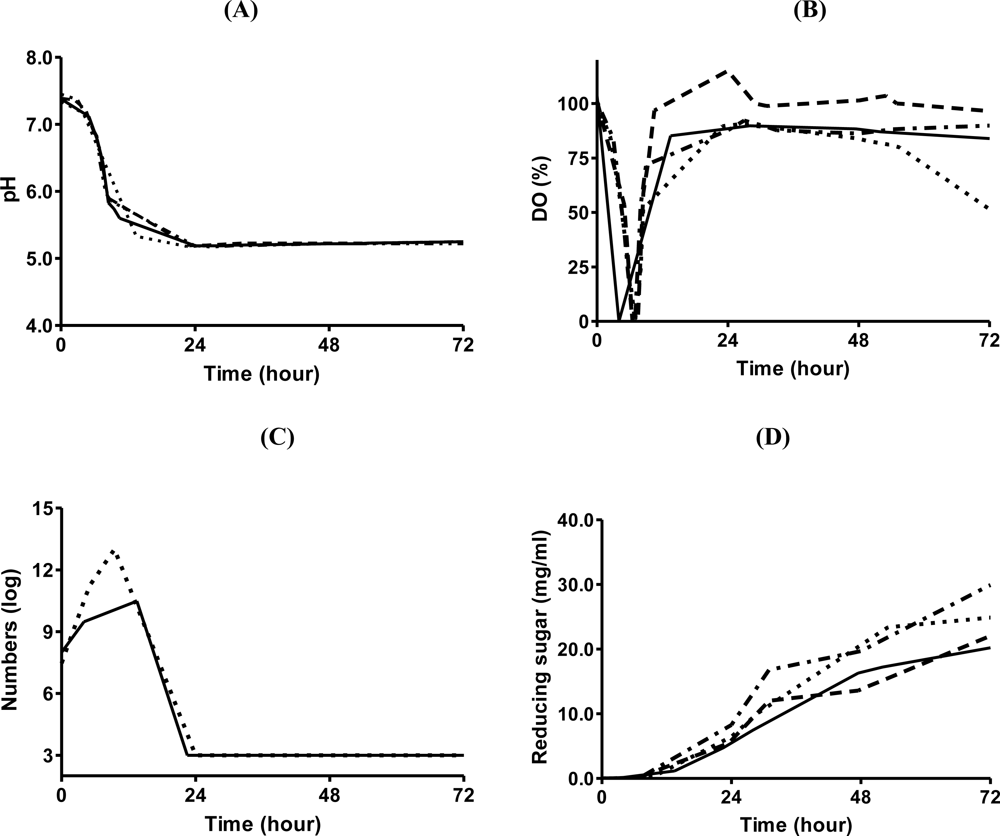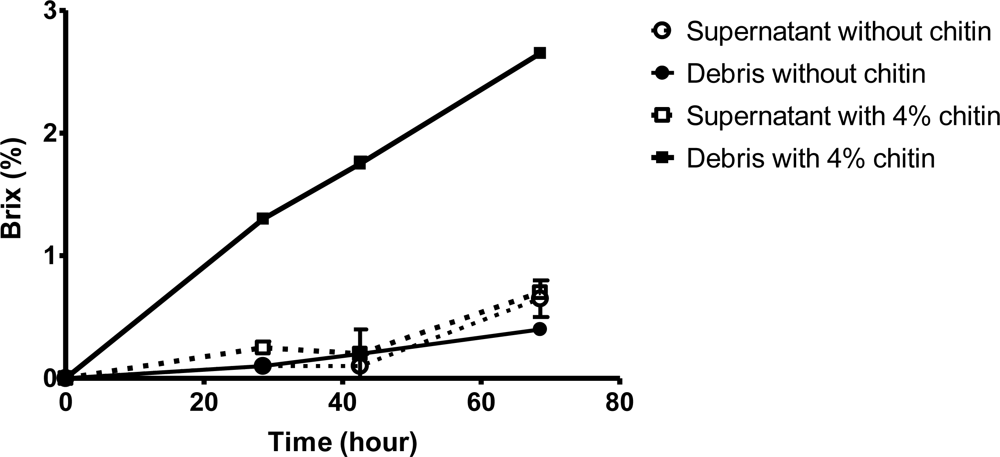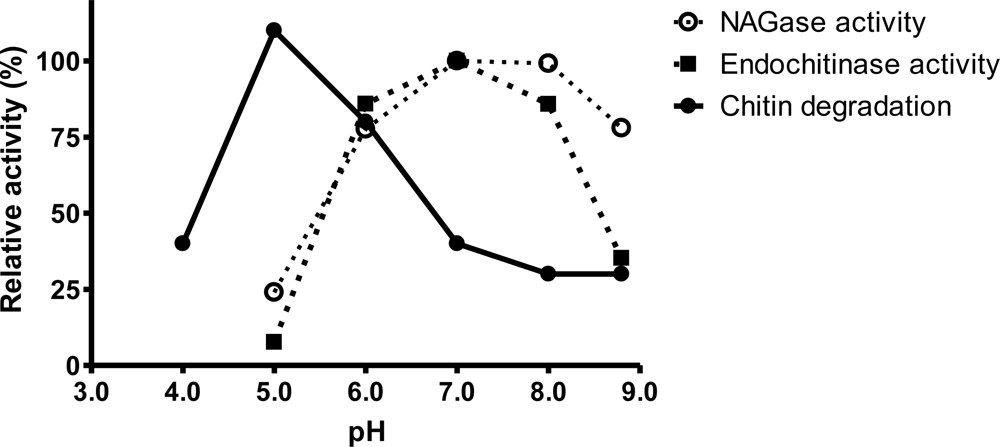N-Acetyl Glucosamine Obtained from Chitin by Chitin Degrading Factors in Chitinbacter tainanesis
Abstract
:1. Introduction
2. Results and Discussion
2.1. Degradation of Chitin by “Chitin Degrading Factors”
2.2. Chitin Degrading Activity of Bacterial Debris
2.3. Chitin Degrading Effects of Fractions Isolated from the Bacterial Debris
3. Experimental Section
3.1. Materials
3.2. Fermentation of C. tainanensis
3.3. Preparation of Bacterial Debris and Its Components
3.4. Analysis of Chitin Degrading Effect and Enzymatic Activity
4. Conclusion
Acknowledgments
References
- Flash, J; Pilet, PE; Jolles, P. What’s new in chitin research? Experientia 1992, 48, 701–716. [Google Scholar]
- Shibata, Y; Foster, LA; Metzger, WJ; Myrvik, QN. Alveolar macrophage priming by intravenous administration of chitin particles, polymers of N-acetyl-D-glucosamine, in mice. Infect. Immun 1997, 65, 1734–1741. [Google Scholar]
- Shibata, Y; Honda, I; Justice, JP; van Scott, MR; Nakamura, RM; Myrvik, QN. Th1 adjuvant N-acetyl-d-glucosamine polymer up-regulates Th1 immunity but down-regulates Th2 immunity against a mycobacterial protein (MPB-59) in interleukin-10-knockout and wild-type mice. Infect. Immun 2001, 69, 6123–6130. [Google Scholar]
- Suzuki, K; Mikami, T; Okawa, Y; Tokoro, A; Suzuki, S; Suzuki, M. Antitumor effect of hexa-N-acetylchitohexaose and chitohexaose. Carbohydr. Res 1986, 151, 403–408. [Google Scholar]
- Creamer, P. Osteoarthritis pain and its treatment. Curr Opin Rheumatol 2000, 12, 450–455. [Google Scholar]
- Aam, BB; Heggset, EB; Norberg, AL; Sorlie, M; Varum, KM; Eijsink, VG. Production of chitooligosaccharides and their potential applications in medicine. Mar. Drugs 2010, 8, 1482–1517. [Google Scholar]
- Yang, CJ; Liu, YK; Liu, CL; Shen, CN; Kuo, ML; Su, CC; Tseng, CP; Yen, TC; Shen, CR. Inhibition of acidic mammalian chitinase by RNA interference suppresses ovalbumin-sensitized allergic asthma. Hum. Gene Ther 2009, 20, 1597–1606. [Google Scholar]
- Shen, CR; Juang, JH; Tsai, ZT; Wu, ST; Tsai, FY; Wang, JJ; Liu, CL; Yen, TC. Preparation, characterization and application of superparamagnetic iron oxide encapsulated with N-[(2-hydroxy-3-trimethylammonium) propyl] chitosan chloride. Carbohydr. Polym 2011, 84, 781–784. [Google Scholar]
- Chen, JK; Shen, CR; Liu, CL. N-acetylglucosamine: production and applications. Mar. Drugs 2010, 8, 2493–2516. [Google Scholar]
- Talent, JM; Gracy, RW. Pilot study of oral polymeric N-acetyl-d-glucosamine as a potential treatment for patients with osteoarthritis. Clin. Ther 1996, 18, 1184–1190. [Google Scholar]
- Salvatore, S; Heuschkel, R; Tomlin, S; Davies, SE; Edwards, S; Walker-Smith, JA; French, I; Murch, SH. A pilot study of N-acetyl glucosamine, a nutritional substrate for glycosaminoglycan synthesis, in paediatric chronic inflammatory bowel disease. Aliment Pharmacol. Ther 2000, 14, 1567–1579. [Google Scholar]
- Bissett, DL; Robinson, LR; Raleigh, PS; Miyamoto, K; Hakozaki, T; Li, J; Kelm, GR. Reduction in the appearance of facial hyperpigmentation by topical N-acetyl glucosamine. J. Cosmet. Dermatol 2007, 6, 20–26. [Google Scholar]
- Kimball, AB; Kaczvinsky, JR; Li, J; Robinson, LR; Matts, PJ; Berge, CA; Miyamoto, K; Bissett, DL. Reduction in the appearance of facial hyperpigmentation after use of moisturizers with a combination of topical niacinamide and N-acetyl glucosamine: results of a randomized, double-blind, vehicle-controlled trial. Br. J. Dermatol 2010, 162, 435–441. [Google Scholar]
- Sashiwa, H; Fujishima, S; Yamano, N; Kawasaki, N; Nakayama, A; Muraki, E; Sukwattanasinitt, M; Pichyangkura, R; Aiba, SI. Enzymatic production of N-acetyl-d-glucosamine from chitin. Degradation study of N-acetylchitooligosaccharide and the effect of mixing of crude enzymes. Carbohydr. Polym 2003, 51, 391–395. [Google Scholar]
- Kuk, JH; Jung, WJ; Hyun, JG; Ahn, JS; Kim, KY; Park, RD. Selective preparation of N-acetyl-D-glucosamine and N,N′-diacetylchitobiose from chitin using a crude enzyme preparation from Aeromonas sp. Biotechnol. Lett 2005, 27, 7–11. [Google Scholar]
- Li, YL; Wu, ST; Yu, ST; Too, JR. Screening of a microbe to degrade chitin. Taiwan. J. Agric. Chem. Food Sci 2005, 43, 410–418. [Google Scholar]
- Sashiwa, H; Fujishima, S; Yamano, N; Kawasaki, N; Nakayama, A; Muraki, E; Aiba, SI. Production of N-acetyl-d-glucosamine from beta-chitin by enzymatic hydrolysis. Chem Lett 2001, 308–309. [Google Scholar]
- Sashiwa, H; Fujishima, S; Yamano, N; Kawasaki, N; Nakayama, A; Muraki, E; Hiraga, K; Oda, K; Aiba, S. Production of N-acetyl-d-glucosamine from alpha-chitin by crude enzymes from Aeromonas hydrophila H-2330. Carbohydr. Res 2002, 337, 761–763. [Google Scholar]
- Chern, LL; Stackebrandt, E; Lee, SF; Lee, FL; Chen, JK; Fu, HM. Chitinibacter tainanensis gen. nov., sp. nov., a chitin-degrading aerobe from soil in Taiwan. Int. J. Syst. Evol. Microbiol 2004, 54, 1387–1391. [Google Scholar]
- Liu, CL; Shen, CR; Hsu, FF; Chen, JK; Wu, PT; Guo, SH; Lee, WC; Yu, FW; Mackey, ZB; Turk, J; Gross, ML. Isolation and identification of two novel SDS-resistant secreted chitinases from Aeromonas schubertii. Biotechnol. Prog 2009, 25, 124–131. [Google Scholar]
- Kurita, K; Kaji, Y; Mori, T; Nishiyama, Y. Enzymatic degradation of beta-chitin: Susceptibility and the influence of deacetylation. Carbohydr. Polym 2000, 42, 19–21. [Google Scholar]
- Shoham, Y; Lamed, R; Bayer, EA. The cellulosome concept as an efficient microbial strategy for the degradation of insoluble polysaccharides. Trends Microbiol 1999, 7, 275–281. [Google Scholar]
- Hsu, SC; Lockwood, JL. Powdered chitin agar as a selective medium for enumeration of actinomycetes in water and soil. Appl. Microbiol 1975, 29, 422–426. [Google Scholar]
- Shen, CR; Chen, YS; Yang, CJ; Chen, JK; Liu, CL. Colloid chitin azure is a dispersible, low-cost substrate for chitinase measurements in a sensitive, fast, reproducible assay. J. Biomol. Screen 2010, 15, 213–217. [Google Scholar]
- Imoto, T; Yagishita, K. A simple activity measurement of lysozyme. Agri. Biol. Chem 1971, 35, 1154–1156. [Google Scholar]
- Wang, S; Moyne, A; Thottappilly, G; Wu, S; Locy, RD; Singh, NK. Purification and characterization of a Bacillus cereus exochitinase. Enzyme Microb. Technol 2001, 28, 492–498. [Google Scholar]
- Guo, SH; Chen, JK; Lee, WC. Purification and characterization of extracellular chitinase from Aeromonas schubertii. Enzyme Microb. Technol 2004, 35, 550–556. [Google Scholar]




© 2011 by the authors; licensee MDPI, Basel, Switzerland. This article is an open-access article distributed under the terms and conditions of the Creative Commons Attribution license (http://creativecommons.org/licenses/by/3.0/).
Share and Cite
Chen, J.-K.; Shen, C.-R.; Yeh, C.-H.; Fang, B.-S.; Huang, T.-L.; Liu, C.-L. N-Acetyl Glucosamine Obtained from Chitin by Chitin Degrading Factors in Chitinbacter tainanesis. Int. J. Mol. Sci. 2011, 12, 1187-1195. https://doi.org/10.3390/ijms12021187
Chen J-K, Shen C-R, Yeh C-H, Fang B-S, Huang T-L, Liu C-L. N-Acetyl Glucosamine Obtained from Chitin by Chitin Degrading Factors in Chitinbacter tainanesis. International Journal of Molecular Sciences. 2011; 12(2):1187-1195. https://doi.org/10.3390/ijms12021187
Chicago/Turabian StyleChen, Jeen-Kuan, Chia-Rui Shen, Chao-Hsien Yeh, Bing-Shiun Fang, Tung-Li Huang, and Chao-Lin Liu. 2011. "N-Acetyl Glucosamine Obtained from Chitin by Chitin Degrading Factors in Chitinbacter tainanesis" International Journal of Molecular Sciences 12, no. 2: 1187-1195. https://doi.org/10.3390/ijms12021187



